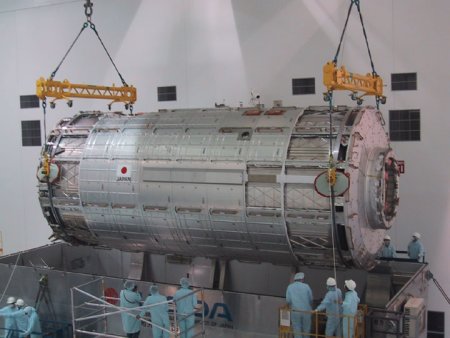Kibo Japanese Experiment Module

Kibo's Pressurized Module, shown here at its manufacturing facility in Nagoya, Japan. Photo courtesy of JAXA.
The Japanese Experiment Module, or JEM, called Kibo ('hope' in Japanese) is Japan's first human space facility and enhances the research capabilities of the International Space Station.
Experiments in Kibo focus on space medicine, biology, Earth observations, material production, biotechnology and communications research. Kibo experiments and systems are operated from the Mission Control Room at the Space Station Operations Facility, or SSOF, at Tsukuba Space Center in Ibaraki Prefecture, Japan, just north of Tokyo.
Kibo consists of six components: two research facilities – the Pressurized Module and Exposed Facility; a Logistics Module attached to each of them; a Remote Manipulator System; and an Inter-Orbit Communication System unit. Kibo also has a scientific airlock through which experiments are transferred and exposed to the external environment of space. The various components of JEM will be assembled in space over the course of three Space Shuttle missions. The missions are designated assembly flights 1J, 1J/A and 2J/A.
Pressurized Module
The Pressurized Module, or PM, provides a shirt-sleeve environment in which astronauts conduct microgravity experiments. There are a total of 23 racks, including 10 experiment racks, inside the PM providing a power supply, communications, air conditioning, hardware cooling, water control and experiment support functions.
The PM is 11.2 meters (36.7 feet) long and 4.4 meters (14.4 feet) in diameter, about the size of a large tour bus.
Exposed Facility
The Exposed Facility, or EF, is a unique platform on the ISS that is located outside of the Pressurized Module and is continuously exposed to the space environment. Astronauts exchange experiment payloads or hardware from the Pressurized Module through the scientific airlock using the Kibo Remote Manipulator System. Items positioned on the exterior platform focus on Earth observation as well as communication, scientific, engineering and materials science experiments.
The EF is a platform that can hold up to 10 experiment payloads at a time and measures 5.6 meters (18.4 feet) wide, 5 meters (16.4 feet) high and 4 meters (13.1 feet) long.
Experiment Logistics Modules (Pressurized and Exposed Sections)
The Experiment Logistics Modules, or ELMs, serve as on-orbit storage areas that house materials for experiments, maintenance tools and supplies. The Pressurized Module and the Exposed Facility each have an ELM.
Pressurized Section:The Experiment Logistics Module - Pressurized Section, or ELM-PS, is a short cylinder attached to the top of the Pressurized Module that can hold eight experiment racks. It measures 4.4 meters (14.4 feet) in diameter and 3.9 meters (12.8 feet) long.
Exposed Section: The Experiment Logistics Module - Exposed Section, or ELM-ES, is a pallet that can hold three experiment payloads. It measures 4.9 meters (16.1 feet) wide, 2.2 meters (7.2 feet) high and 4.2 meters (13.8 feet) long.
Remote Manipulator System
The Remote Manipulator System, or RMS, consists of two robotic arms that support operations on the outside of Kibo. The Main Arm can handle up to 6.4 metric tons (14,000 pounds) of hardware and the Small Fine Arm, when attached to the Main Arm, handles more delicate operations. Each arm has six joints that mimic the movements of a human arm.
Astronauts operate the robot arms from a remote computer console inside the Pressurized Module and watch external images from a camera attached to the Main Arm on a television monitor at the RMS console. The arms are specifically used to exchange experiment payloads or hardware located on the Exposed Facility and Experiment Logistics Module - Exposed Section and from inside the Pressurized Module through a scientific airlock, support maintenance tasks of Kibo and handle orbital replacement units.
The operations of a prototype Small Fine Arm were evaluated as part of the Manipulator Flight Demonstration experiment conducted during the STS-85 Space Shuttle mission in 1997.
The Main Arm measures 9.9 m (32.5 ft) long, and the Small Fine Arm measures 1.9 meters (6.2 feet).
Inter-Orbit Communication System
The Inter-Orbit Communication System, or ICS, allows the operators in the Mission Control Room at the SSOF at Tsukuba Space Center to send commands to Kibo and receive system, payload and video data from Kibo for scientific payload operations. The Mission Control Room uses the Tracking and Data Relay Satellite System, or TDRSS, to communicate with the ICS. An external ICS unit handles communications with TDRSS, while an internal ICS unit located in the Pressurized Module handles data exchange throughout the Kibo facilities.
Mission Control Room
The Mission Control Room, or MCR, is the hub of round-the-clock, real-time operations of Kibo. Ongoing control of Kibo systems such as the electric power distribution system and the thermal control system, monitoring the condition of Japanese experiment equipment, sending control commands, and real-time operations planning is conducted here. A flight director oversees all operations in the MCR.
Communication with other control centers and the Space Station crew occur in the MCR. Flight controllers in Japan work in cooperation with controllers at NASA's Mission Control Center in Houston, Texas, the Russian Mission Control Center near Moscow and the Payload Operations Center, Huntsville, Ala.
Experiment status and measurement data are distributed to users from the MCR. Researchers and those in charge of experiment operations are located in a User Operations Area at the SSOF, where they monitor, control and analyze experiment data, as well as support and carry out on-orbit experiments from the ground.


